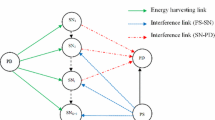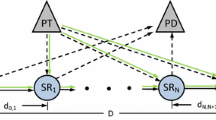Abstract
In this paper, a comparative study of parallel best path selection (PBPS) and immediate best path selection IBPS in terms of outage probability and throughput has been done in a multi hop cognitive radio network. The closed form expressions for the outage probability of secondary network in PBPS protocol as well as IBPS protocol in multihop scenario have been derived. We also find the impact of the number of parallel paths in multihop scenario on the outage probability and throughput of secondary network. The performance of PBPS scheme is compared with IBPS scheme. An optimum value of initial harvesting time for secondary nodes \((\tau )\) to achieve maximum throughput is also found for both the path selection schemes.






Similar content being viewed by others
References
Mitola, J. (1999). Cognitive radio: Making software radios more personal. IEEE Personal Communications, 6(4), 13–18.
Nasir, A. A., Zhou, X., Durrani, S., & Kennedy, R. A. (2013). Relaying protocols for wireless energy harvesting and information processing. IEEE Transactions on Wireless Communications, 12(7), 3622–3636.
Nasir, A. A., Zhou, X., Durrani, S., & Kennedy, R. A. (2014). Throughput and ergodic capacity of wireless energy harvesting based DF relaying network. In IEEE international conference on communications (ICC), 2014 (pp. 4066–4071).
Liu, Y., Mousavifar, S. A., Deng, Y., Leung, Cl, & Elkashlan, Maged. (2016). Wireless energy harvesting in a cognitive relay network. IEEE Transactions on Wireless Communications, 15(4), 2498–2508.
Chi, X., Zheng, M., Liang, W., Haibin, Y., & Liang, Ying-Chang. (2016). Outage performance of underlay multi-hop cognitive relay networks with energy harvesting. IEICE Transactions on Communications, 6(20), 1148–1151.
Krikidis, I., Zheng, G., & Ottersten, B. (2013). Harvest-use cooperative networks with half/full-duplex relaying. In Wireless communications and networking conference (WCNC), 2013 IEEE, (pp. 4256–4260). IEEE.
Tuyen, L. P., & Bao, V. N. Q. (2012). Outage performance analysis of dual-hop af relaying system with underlay spectrum sharing. In IEEE 14th international conference on advanced communication technology (ICACT), 2012, (pp 481–486).
Lee, J., Wang, H., Andrews, J. G., & Hong, D. (2011). Outage probability of cognitive relay networks with interference constraints. IEEE Transactions on Wireless Communications, 10(2), 390–395.
Najafi, M., Ardebilipour, M., Soleimani-Nasab, E., & Vahidian, S. (2015). Multi-hop cooperative communication technique for cognitive df and af relay networks. Wireless Personal Communications, 83(4), 3209–3221.
Mondal, S., Roy, S. D., & Kundu, S. (2017). Energy harvesting based multihop relaying in cognitive radio network. Wireless Personal Communications, 97, 1–18.
Mondal, S., Roy, S. D., & Kundu, S. (2017). Primary behaviour based energy harvesting multihop cognitive radio network. IET Communications, 11, 2466–2475.
Mao, M., Cao, N., Chen, Y., & Zhou, Y. (2015). Multi-hop relaying using energy harvesting. IEEE Wireless Communications Letters, 4(5), 565–568.
Bao, V. N., Quoc, T. T., Thanh, T. D., & Vu, T. D. (2013). Spectrum sharing-based multi-hop decode-and-forward relay networks under interference constraints: performance analysis and relay position optimization. Journal of Communications and Networks, 15(3), 266–275.
Bao, V. N. Q., Duong, T. Q., da Costa, D. B., Alexandropoulos, G. C., & Nallanathan, Arumugam. (2013). Cognitive amplify-and-forward relaying with best relay selection in non-identical rayleigh fading. IEEE Communications Letters, 17(3), 475–478.
Do, N. T., Bao, V. N. Q., & An, B. (2016). Outage performance analysis of relay selection schemes in wireless energy harvesting cooperative networks over non-identical rayleigh fading channels. Sensors, 16(3), 295.
Nguyen, N.-P., Duong, T. Q., Ngo, H. Q., Hadzi-Velkov, Z., & Shu, Lei. (2016). Secure 5g wireless communications: A joint relay selection and wireless power transfer approach. IEEE. access, 4, 3349–3359.
Doan, X.-T., Nguyen, N.-P., Yin, C., Da Costa, D. B., & Duong, Trung Q. (2017). Cognitive full-duplex relay networks under the peak interference power constraint of multiple primary users. EURASIP Journal on Wireless Communications and Networking, 2017(1), 8.
Boddapati, H. K., Prakriya, S., & Bhatnagar, M. R. (2016). Outage analysis of cluster-based multi-hop cognitive radio networks. In IEEE 83rd vehicular technology conference (VTC Spring), 2016, (pp. 1–5).
Bhatnagar, M. R, Mallik, R. K., & Tirkkonen, O. (2016). Performance evaluation of best-path selection in a multihop decode-and-forward cooperative system. IEEE Transactions on Vehicular Technology, 65(4), 2722–2728.
Barua, B., Safaei, F., & Abolhasan, M. (2010). On the outage of multihop parallel relay networks. In IEEE 72nd vehicular technology conference fall (VTC 2010-Fall), 2010, (pp. 1–5).
Kumar, D., & Kumar, A. (2016) Outage probability analysis of multihop-multicast cooperative system. International Journal of Computer Applications, 148(5).
Gradshteyn, I. S., & Ryzhik, I. M. (2014). Table of integrals, series, and products. New York: Academic press.
Acknowledgements
The work is supported by Visvesvaraya research grant under Media Lab Asia (PhD-MLA/4(29)/2015-16).
Author information
Authors and Affiliations
Corresponding author
Additional information
Publisher’s Note
Springer Nature remains neutral with regard to jurisdictional claims in published maps and institutional affiliations.
Appendix
Appendix
1.1 A.1 Appendix I: Proof of proposition 1 in (14)
Proof
Considering the interference contributed by PT, the cdf of SINR become analytically untraceable. To avoid the mathematical complexity we do not consider interference. From the (7), we can write
In \(P^{PBPS}_1\) of (19), X and Y are independent over a given Z and taking expected value of \(P_1\) over the distribution Z, we have
where \(\;\int \nolimits _0^\infty {{e^{ - \;\frac{\beta }{{4x}} - \gamma x}}dx} = \sqrt{\frac{\beta }{\gamma }} {K_1}\left( {\sqrt{\beta \gamma } } \right) \) is used [22, §3.324.1] and \(K_1(.)\) is the first order modified Bessel function of the second kind.
In \(P^{PBPS}_2\) of (19), X and Z are independent over a given Y and taking expected value of \(P_2\) over the distribution Y, we have
Similar as (20), \(\;\int \limits _0^\infty {{e^{ - \;\frac{\beta }{{4x}} - \gamma x}}dx} = \sqrt{\frac{\beta }{\gamma }} {K_1}\left( {\sqrt{\beta \gamma } } \right) \) is used [22, §3.324.1]. Plugging (20) and (21) in (19), we obtain the \({F^{PBPS}_{{\gamma _{({l^{**}},m + 1)}}}}({\gamma _{th}}){\mathrm{{ }}}\) expression in (14). \(\square \)
1.2 A.2 Appendix II: Proof of proposition 2 in (18)
Proof
Considering the interference coming from PT, the cdf of SINR becomes analytically untraceable. To reduce the mathematical complexity, we neglect the interference from PT. From the (7), we can write
\(\square \)
Plugging (23) and (24) in (22), we obtain the \({F^{IBPS}_{{\gamma _{({l^{**}},m + 1)}}}}({\gamma _{th}}){\mathrm{{ }}}\) expression in (18).
Rights and permissions
About this article
Cite this article
Mondal, S., Roy, S.D. & Kundu, S. Closed-Form Outage Probability Expressions for Multihop Cognitive Radio Network with Best Path Selection Schemes in RF Energy Harvesting Environment. Wireless Pers Commun 103, 2197–2212 (2018). https://doi.org/10.1007/s11277-018-5904-1
Published:
Issue Date:
DOI: https://doi.org/10.1007/s11277-018-5904-1




